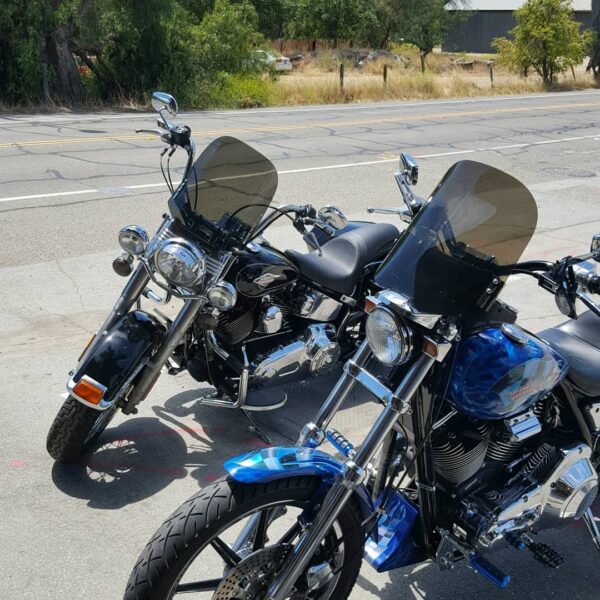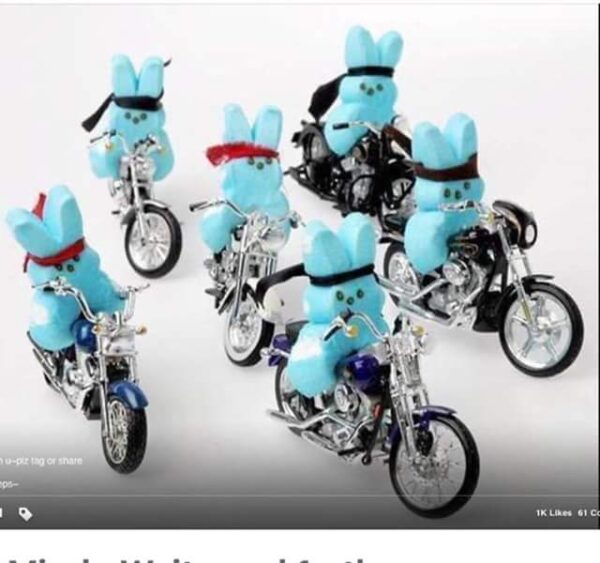Sportster Futures
By Wayfarer |
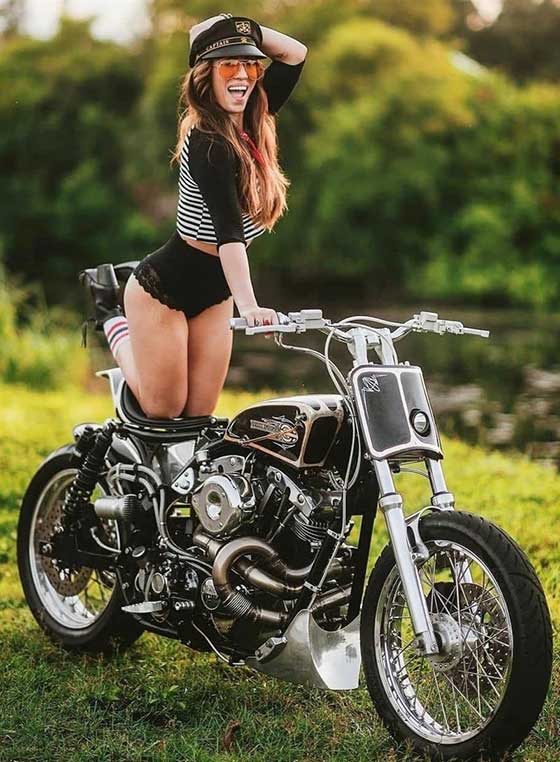 Earlier this year we heard that Harley was going to cancel the Sportster line. We also started a suggestion box for the factory’s success. Of course, one of our first and most supported recommendations included retaining the Sportster line.
I went so far as to recommend the Sportster line become the builder’s line and make the models user and hands- on friendly. They could work with the aftermarket on custom and performance product lines and teach owners how to work on, service and customize their Sportsters.
Earlier this year we heard that Harley was going to cancel the Sportster line. We also started a suggestion box for the factory’s success. Of course, one of our first and most supported recommendations included retaining the Sportster line.
I went so far as to recommend the Sportster line become the builder’s line and make the models user and hands- on friendly. They could work with the aftermarket on custom and performance product lines and teach owners how to work on, service and customize their Sportsters.
Click Here to Read this Feature Article on Bikernet.
Join the Cantina – Subscribe Today.
https://www.bikernet.com/pages/custom/subscription.aspx
Sam Lowes wins double in Doha
By Wayfarer |
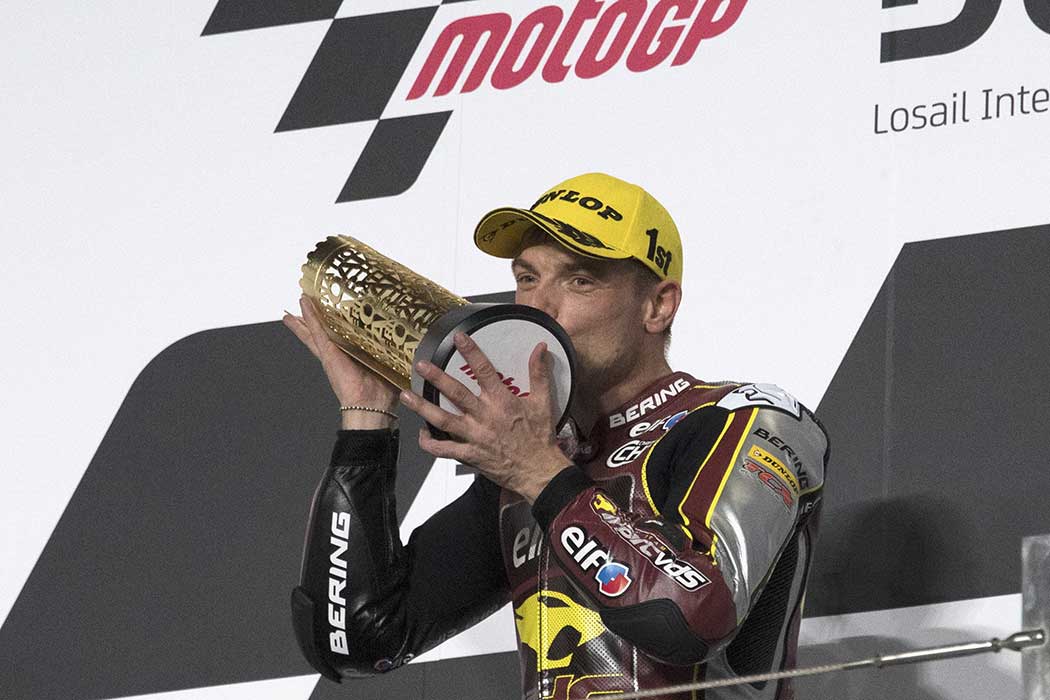
Lowes holds nerve for brilliant Doha double!
Sam Lowes emerged victorious in a thrilling late duel to win his second Moto2 race in succession while Augusto Fernandez made big strides to score an excellent sixth.
The Losail International Circuit was the scene of a second Moto2 race in as many weeks, and was one where Elf Marc VDS Racing Team riders Sam Lowes and Augusto Fernandez both finished in the top six.
Despite the strong wind, Lowes’ race winning pace was incredible. The Englishman posted a new race record time for the Moto2 class – 39’52.702 – and was over 10 seconds quicker than the race here one week ago.
After making drastic changes to his set-up on Friday, Augusto felt more comfortable in race two. Starting from tenth on the grid, the 23-year old was in the midst of an eight-rider fight for fifth place for the entire race.
He finished the race strongly, and climbed one place on the last lap to finish sixth. To show his improvement over the second weekend of the year, Fernandez’s race time was 11 seconds faster than he managed one week ago.
“I’m getting my confidence back”
“I’m very happy! It seems this set-up direction is the correct one. It has been a really hard two weeks here. We were a bit lost in the test and the first race, changing parts. And we didn’t have so much time to test for the races because of the times of the sessions. It was difficult to turn around the situation. But after a tough start, we got sixth position and sit seventh in the championship. Also, I’m getting my confidence back. The end of the race was so strong. I had good pace and was making 1’59s. I was strong on the brakes and passing a lot of people. We will take all of these positives to Portimao. Step by step we are getting closer.”
Starting from his second pole position of the season, Lowes got a solid start and passed early leader Marco Bezzecchi on the fourth lap of 20.
But this wasn’t straightforward. Lowes faced intense pressure from Remy Gardner through the second half of the race. His lead never exceeded 0.483s but he kept his composure, and posted the fastest time of the race – a 1’58.954 – on the last lap to win by 0.190s.
Lowes’ victory means he is the first rider in Moto2 history to win the opening two races from pole position. What’s more, he becomes the first British rider to win the first two races of the season in the intermediate category since Mike Hailwood did so in 1966!
“I think we saved the best for last”
“We had three weeks here in the desert with very changeable conditions. It was definitely not easy. But I think we saved the best for last! That was really fast race pace – the fastest we’ve had in Qatar in Moto2. I’m really happy with how I approached these two races. I feel I’ve improved in myself and can be more relaxed in the race. I know it’s only the start of the year, but it’s been a really good start. To have somebody behind me all race and not make any mistakes is really important and that will give me a lot of confidence. When I won last year and last week, I had a bigger gap so this was a bit different and I managed fine and felt really comfortable. I’m looking forward to getting to Portugal and being able to ride there with two hands this time! Last year that wasn’t the case. We’ve had a great few weeks, everyone is ready for home and I couldn’t be happier to take 50 points back.”
HAPPY EASTER FROM WIND VEST
By Bandit |
Wishing Everyone a Happy and Safe Easter Holiday!
Tips to keeping your WindVest Looking like New
The best way to keep your WindVest looking like new is to start by cleaning it with mild soap and water. Treat it like you would your paint. You can use a non-abrasive wax or a detail spray. We recommend Novus #1 for cleaning and conditioning. Stay away from any alcohol based products, such as window cleaner. The screen is an open pored product and could get a hazy look. It’s ok in a pinch. If you are at a gas station DO NOT be tempted to use the squeegee. This will scratch the screen.
Visit or website
WindVest Motorcycle Products
16840 Joleen Way, Ste B2
Morgan Hill, CA 95037
408-762-7180
sales@windvest.com
Happy Easter from J.J. Solari
By Bandit |
I drempt that we were on the Strip /
taking a tourist walking trip /
i put my hand under your pants /
and thought “I’ll woo her with romance” /
down your backside went my hand /
and stopped on one half of assland /
you made no move to interrupt /
me or your cheek that I had cupped /
my hand, your ass, were now conjoined /
very close to where you were loined. /
as we walked my hand stayed firm /
against your cheek, i think a germ /
could not have even found the room /
to wriggle from this hand-ass tomb /
so tight against your flesh was my /
hand pressed in joy so near your thigh /
“I could just move around the front /
and be romantic with her cunt” /
 was what my silent thoughts were saying /
was what my silent thoughts were saying /
yet on your ass my hand was staying /
it did not seem to want to move /
though once it brushed your buttcheek groove /
and then returned to buttcheekland /
where your ass magnetized my hand /
to stay there and to move no more /
no further body parts to explore /
and then i woke up with a squirt /
that pierced the floor and kicked up dirt. /
burma shave.
SPORTSTER FUTURES
By Bandit |

Earlier this year we heard that Harley was going to cancel the Sportster line. We also started a suggestion box for the factory’s success. Of course, one of our first and most supported recommendations included retaining the Sportster line.


I went so far as to recommend the Sportster line become the builder’s line and make the models user and hands- on friendly. They could work with the aftermarket on custom and performance product lines and teach owners how to work on, service and customize their Sportsters.

The history of the Sportster line is crazy and the longest model line in the history of Harley-Davidson. The Harley-Davidson Sportster is a line of motorcycles produced continuously since 1957 by Harley-Davidson. Sportster models are designated in Harley-Davidson’s product code by beginning with “XL”.

In 1952, the predecessors to the Sportster, the Model K Sport and Sport Solo motorcycles, were introduced. These models K, KK, KH, and KHK of 1952 to 1956 had a sidevalve (‘flat head’) engine, whereas the later XL Sportster models use an overhead valve engine. The first Sportster in 1957 had many of the same details of the KH including the frame, fenders, large gas tank and front suspension.

During the ‘50s and ‘60s the only entry level Harley became the Sportster. You could buy a dresser or a Sportster. At the time, no one wanted a dresser except old straights. We all started on Sportsters. It wasn’t until ’71 that the factory started to build big twins that weren’t dressers, with the Super Glide.

Following are some thoughts from some of the bros and an inspirational batch of shots from Sam Burns of iconic Sportsters. Feel free to share your thoughts with us supporting the Sportster Model Line. Send them to KBall945@gmail.com.

From Sam Burns:
I was thinking about the possible demise of the venerable Sportster from the Harley lineup. Considering what Triumph, Ducati, Moto Guzzi, BMW, Ford, GM, Chrysler, and others have been doing with all the retro scene it amazes me that a modern but true to the mark Sportster isn’t in the making.

Sixty-five years and the K lineage preceding that. I’m a Texan born and bred, but while up North, it seemed Sportsters were everywhere. The Factory could build something for us old boys to relive when the Sportster ruled the street and writers were calling it our first true superbike.

It has been a great street bike, drag racer, hillclimber, road racer, and touring bike. Affordable and easily customized, it still is a base for many custom bikes.

Maybe I’m just getting old and going through the memory bin, but I still see the Sportster as a viable platform.

—Sam Burns

From Micah McCloskey
The Sportster has been around since the 1952 K Model. It outperforms the other models in handling, braking, shifting, and racing.

The lightweight design also makes it a great entry level motorcycle for a novice to develop riding skills with. They have been very popular with around town riders, woman, and young riders without a fat wallet.

Indian Scouts won all the races in the ‘40s and ‘50s until the Sportster hit the scene. It took awhile but Sportsters started to win flat track races for Harley-Davidson. When drag racing started to shake neighborhood asphalt ¼ mile tracks the bikes to beat were Sportsters. All the greats built fuel powered Sportster drag bikes.

–Micah McCloskey

More from Sam Burns
Regarding retro: Dodge kinda kicked it off with the hemi (sweet). Ford came out with the retro-styled Mustang and the streets were full of everything pony car (Camaro, Challenger, Charger). BMW with their new R18 and Ducati with their scramblers. Triumph (the Sportster’s old nemesis) and Guzzi with the 750s new replacement.

The good news is that the old is what’s cool with the Sportster style. The 650 Bonneville has grown to 900 and 1200 with a host of new technology but it is unmistakably a Bonnie.

–Sam Burns

I stepped into the mix:
It’s interesting to note Indian’s recent progress. After the launch of the Chief Classic in 2014 they immediately created the Scout to compete with the Sportster. And this year they redesigned their Chief line to look more like a Sportster and be the cruiser of the Indian line. Retro and classic, the Sportster contains all the winning elements.

–Bandit

From the Stealth:
After hearing that the Sportster line-up would cease to exist after 2021, I was confused and a bit sad. In my opinion this is a huge mistake. How many of us got into Harleys with a Sportster? More than I can count.

My first Harley was a 1979 Sportster. It was called a Hugger back then first 16-inch rear wheel from the factory on a Sportster. It was scarlet red. I had a lot of good times on this bike. For me Sportsters have always been bad ass and I can hear a lot of you sating right now it is a girl’s bike, to that I say bullshit! If this were the case why are all Harley race programs based off the Sportster?

Look at Arlen Ness’s early bikes, a lot of them were based off the Sportster engine! I would get off work at 11:30 pm back in those days and I could not wait to get to the parking lot to go for a midnight ride. Nothing was cooler than when I let off the throttle and I would look back at the flames dancing out of the drag pipes.

Great times on a great bike! That Sportster attracted a lot of attention from the ladies also! Hey Elvis had a Sportster that says something! To this day the Sportster tank is the cleanest sexiest gas tank ever made!

When I was a kid in the 10th grade I would go to the local dealer after school and sit on a Sportster, I would look at the shiny surface of the tank and see myself looking back at me, telling myself SOMEDAY! I never thought of a Super glide or an Electra Gide I had the Sportster bug!

Sportsters carry a lot of memories for a lot of riders It was always your key to the Biker lifestyle. The Sportster still has one of the best exhaust notes around with those nine cams. Harley needs to re-think the idea of doing away with the Sportster–not everyone wants a touring bike. The Sportster has been with us for years, and it has earned the right to remain in the Harley-Davidson line-up!

In my business, I hear the Sportster tank is not big enough, no luggage space etc. Hey, a Sportster is a thoroughbred not a work horse! LONG LIVE THE SPORSTER!

Until next time, RIDE
Sam is back:
This is my brother Ricko. We started riding together over 50 years ago. Here he is with his brand new 1972 XLCH 1000. With a little help from his friends, he acquired a custom rear fender, struts, seat, and front wheel.

He had a great guy, Bill Drake, who set up the rear fender, paint, and general assembly including the SU carburetor. Bill gave so freely of his time, talent, and knowledge. We lost Bill two years ago and he is missed. Among so many other things, Little John introduced us to the SU. We lost John in 1990.
This bike was quick and Ricko could ride like nobody’s business.

My brother Rick says he spoke with the senior salesman at the local Harley dealer and was told that the Sportster line would remain but a couple of Sportster models that weren’t selling very well, would be dropped.
–Sam Burns

From the Gearhead:
I had a few friends who owned them. They haul ass with few modifications depending on the year. Fairly easy to work on with basic tools. Make a pretty good red light to red light hot rod. It gave the competition hell on the flat track and speedway. I had a friend that had a rigid chop in florescent pink with thunder header and could pull wheel stands with his 230-pound frame. It was a long chop too.

–Gearhead

Harley-Davidson’s Golden Age of Racing
D. William Denish, Photography by D. William Denish February 24, 2009
Here’s the author’s street Sportster in early ’68 with a 74ci engine, Dytch big-bore cylinders, 12:1 compression pistons, S&S; 4-5/8 inch stroke flywheels, bored Linkert DC carb, Sifton cams, magneto ignition, and kick-start.
In the summer of 1964, I got a hankering to get a Harley. Maybe my rekindled interest in cycles was because my friend Marty, who previously owned the Whizzer Sportsman, had bought a Panhead and was boring and stroking it out to 98 cubic inches.

As it turned out, I ended up buying a ’64 Harley. Officially, it was called an XLCH Sportster. The CH stood for Competition Hot. Unofficially, it was the Corvette of the motorcycle world-rugged, super-fast, and bulging with torque. All 55 cubic inches delivered 55 horsepower at 6,300 rpm-good for a 14.75 E.T. and 92 mph in the quarter mile.

Nevertheless, since I hopped up scooters as a kid, it was only natural to soup up the Sporty. As such, I contacted an old high school friend, Mark, who was working as a mechanic at the same Harley dealer my friends and I often visited years ago on Friday nights. Mark and his buddies quickly pointed me in the right direction for Harley performance: Tom Sifton, Doc Dytch, Jerry Branch, C.R. Axtell, Tom Rudd, and S&S, just to name a few.

So, during the winter of ’64, out came the stock motor parts and in went 4-9/16-inch KH stroker flywheels, Doc Dytch two-ring stroker pistons, Sifton “minus-plus” cams, big XLR valves, bored-out Linkert DC carb and velocity stack, gutted mufflers, and close C-ratio transmission gears.

The reworked 65-cubic inch motor pushed quarter mile performance to 12.10 E.T. at 110 mph. However, kick-starting the 65-incher was dreadful because it kicked back with such ferocity. When starting, I had to not only precisely position the pistons on the compression stroke, but also depress the ignition kill button until halfway through the kick to minimize kickback. Once the engine kicked back so hard that it sprained my ankle. For over a month, I had to beg my friends to start my bike so I could ride with them. I didn’t think it was very funny, but they sure did.

The winter of ’67 saw the addition of Dytch 3-3/16-inch big bore cylinders, Sifton “minus-minus” cams, stronger 4-5/8-inch stroke forged S&S flywheels and beefed-up crankcases. With 74ci, performance increased to 11.40 E.T. at 117 mph. During the winter of 1968, I replaced the bored-out Linkert with the new big-bore S&S; carb, one of the first 100 made by S&S.; The longer duration “minus-minus” cams made kick-starting the engine easier.

Eventually, I bumped engine displacement to 86 cubic inches by way of 3-7/16-inch Trock cylinders, along with a beefy Trock transmission door, more radical Sifton cams, Baisley modified heads, and a 2-inch SU carb. Performance increased to 11.10 E.T. at 121 mph with narrow street tires and no wheelie bar. At this point, the engine had more power than the short wheelbase frame and 120 rear tire could handle.

At about the same time, Harley legend and top drag racer Leo Payne was tearing up the racetracks on his 75ci street Sportster, dubbed “Turnip Eater,” and 74ci lay-down Top Fueler. Leo was an excellent engine builder and master at modifying and tuning gas and fuel carburetors.
Once he began modifying his Sportsters, Leo quickly earned the reputation of having two of the fastest Harleys in the Midwest, turning 11.08s at 125 mph on Turnip Eater and mid-9s at 150 mph on his fueler.

Turnip Eater started life as a ’57 Sportster, and Leo purportedly coined the bike for eating up British imports on the dragstrip. Payne became known for his lightning-quick reaction times, won numerous titles, and set countless records in various sanctioned drag races during the ’60s. In ’69, Payne’s trap speed of 201 mph on Turnip Eater made him the first rider in history to ride a non-streamliner faster than 200 mph.

Although I spoke to Leo a few times, I was formally introduced to him only once. It was in ’71 or ’72 at Jerry Branch’s head porting company in Long Beach, California. Jerry had a place on the second floor of the Wixom Brothers Fairing building. One Saturday I stopped by and Jerry introduced me to Leo. At the time, Leo and Mel Disharoon were busy fussing around on the Long Beach hills, playing with an aircraft altimeter that Leo used for tuning his fuel bike.

The summers of ’68 and ’69 were hotbeds of exciting Harley drag racing activity east of the Mississippi, particularly Atco Raceway in New Jersey where records were made and broken. One of the more exciting races took place at Atco on October 26, 1969, a race I happened to attend.

Many of the top fuel riders were there. The “Top Eight” Top Fuel qualifying positions were as follows: Larry Welsh on Sonny Routts’ new twin-engine Triumph was qualified first at 9.12 E.T; Jim De Salvo at 9.23 on his Harley; Larry Welsh at 9.28 on his Sportster; Guy Leaming at 9.30 on his Harley; Leo Payne 9.30 on his Sportster; defending 1968 champion Bob Barker at 9.37 on his Sportster; Walter Yee on his Harley at 9.40; and Gary Ackermans at 9.42 on his Harley.

Since Larry Welsh was riding two bikes, Routts’ Triumph and his own Sportster, after qualifying, he turned over the riding duties of his Sportster to Cook Nielson. When the smoke cleared at the end of the day, Guy Leaming took home all the marbles with a hole-shot 9.61 over Bob Barker’s faster but losing 9.51.

For me, the ’60s were the golden age of Harley performance and racing. High-dollar, button-start crate engines and rear-wheel dynos were nonexistent, and kick-start was the name of the game.

Performance kits were in their infancy, requiring lots of trial-and-error engine building and testing. And most performance gurus built their own engines. The bikes may not have gone as fast as they do today, or had as much bling, but the times were simpler, the hype was subdued, and the air was filled with a long-lost innocence.
–from the Hot Bike archives

From Bob T.
Never owned one.

–Bob T.

Conclusion:
I could pull in thousands of Sportster Reports. Hell, I didn’t touch some of the major custom builders like Dave Perewitz and Cory Ness who grew up around his Dad customizing Sportsters. The Sportster is one of the best-looking motorcycles ever built.


I remember when the motorcycle press hammered Harley about building tractors against Triumphs, BSAs and Royal Enfields. Then Sportsters kicked their asses. The Sportster gas tank style is iconic in all of motorcycledom. No manufacturer has bested the style or shape of the Sportster Gas Tank.
![]()
Unlike so many motorcycles in history, the Sportster was the perfect purebred, style wise, performance, handling and size. Hell, that’s why manufacturers all over the world are still trying to capture that balance of art and function.

Hang on for future reports about the New Future of Harley-Davidson and the New Sportster Line. We reached out to Harley, but they told us they were restricted from discussing new models at this juncture.

–Bandit


Electric Motorcycles to help in Wildlife Protection
By Wayfarer |
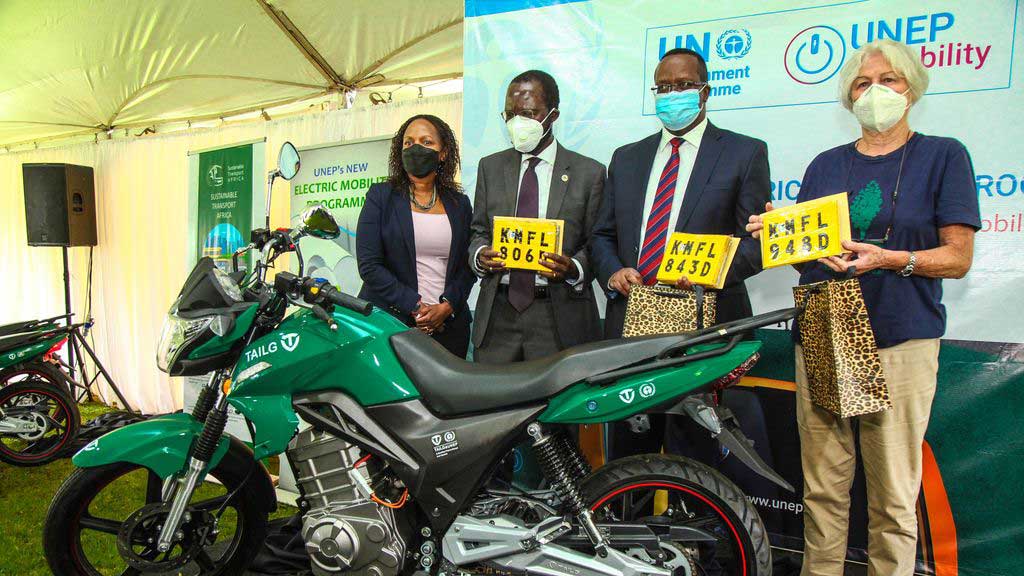
from https://thewestsidegazette.com
Two-Wheeled Hope: Kenya Embraces Electric Motorcycle Project, Ups E-Mobility Goals
One of the world’s largest urban forests sits just outside Nairobi, one of Africa’s busiest cities. Amid its tranquility, the setting is often pierced by ear-splitting gasoline motorbikes emitting fumes as rangers patrol for poachers, intruders and watch over visitors.
“Normally, we use gasoline motorbikes to patrol this forest, making it impossible to nab culprits because of the noise. In many instances, we have been fighting a losing battle,” John Chege, the infrastructure coordinator from Friends of Karura Forest, told Zenger News.
But now, thanks to an electric motorbikes pilot project recently launched in Nairobi, Friends of Karura Forest is getting a donation of electric motorbikes.
Implemented by the United Nations Environmental Program, it is part of a larger initiative: Integrating two and three-wheelers into existing urban transport modes in developing and transition countries. The effort is funded by the International Climate Initiative of the German Federal Ministry of the Environment, Nature and Nuclear.
Thanks to an electric motorbikes pilot project recently launched in Nairobi, Friends of Karura Forest is getting a donation of electric motorbikes. (Courtesy United Nations Environment Program)
The goal is to curb greenhouse gas emissions by helping countries reduce their dependence on fossil fuels.
Chege also said the bikes will help rangers move swiftly and more quietly through the vast forest of 2,752 acres.
“Since they are fast and do not emit much noise and minimal air pollution, we are sure of providing forest security efficiently, while tackling environmental problems,” Chege told stakeholders at the launch.
Despite the Kenyan government hope to transition into a 100 percent green energy nation, with more than 80 percent of its energy coming from hydro, solar, geothermal and wind, it still imports more gasoline motorbikes than cars, doubling its fleet every seven-to-eight years. It’s estimated that the newly registered gasoline motorcycles, commonly used as taxis (boda-boda), which stood at 1.5 million in 2018, will likely hit 5 million by 2030.
With the two and three-wheelers accounting for the same amount of emissions as a passenger car, Africa could see a 50 percent increase in air pollution by 2050 in low- and middle-income countries by 2050, according to a study by the Global Environment Facility.
“Now is a critical moment in the transition to electric mobility. Although we are at relatively low levels, we are 2 percent of sales globally, the change is coming exponentially. The volume is doubling less than every two years,” said Nigel Topping, the UK Government High Level Climate Action Champion for the upcoming United Nations climate talks, known as COP26.
According to Topping, it is possible to end the use of combustion engines and their associated health and climate effects.
“The shift toward electric mobility is a much-needed technology in saving the environment from pollution, and this pilot project will help. We have to grasp this opportunity, which will change the way we move in our cities. We are committed to it,” said James Macharia, Kenya’s Cabinet Secretary for transport, infrastructure, housing, urban development and public works.
Joyce Musya, UNEP deputy executive director, says motorcycles being imported by Kenya are generally inefficient and poorly maintained. “Shifting to electric bikes in Kenya, Rwanda, Uganda and elsewhere will reduce costs, air pollution and greenhouse gas emissions, as well as create jobs,” said Musya.
Environment Program in Nairobi. (Courtesy U.N. Environment Program)
The bikes, donated by Shenzhen Shenling Car Co. Ltd., will last six to 12 months and will be replicated in Uganda, Ethiopia, the Philippines, Thailand and Vietnam.
“We are committed to set up charging ports across the country to support growing demand for electric-powered vehicles and motorbikes,” said Brian Ngugi, managing director at Kenya Power, the country’s electricity transmission company.
The motorcycle industry supports 5.2 million Kenyans directly or indirectly, which is about 10 percent of Kenya’s population. There are 1.4 million motorcycle riders in Kenya.
Keffa Mwendwa, a boda boda rider, has been using an electric bike for six months within Nairobi, courtesy of Ecobodaa, a Nairobi-based startup that operates on a rent-to-own model. He sees many plusses.
“As compared to the gasoline motorbikes, maintenance is cheaper,” Mwendwa said. “I don’t have to do engine services like changing oil or changing chains. I only have to change brake fluid and tire pressure.”
Meet the 95-year-old grandma selling Harley-Davidson motorcycles
By Wayfarer |
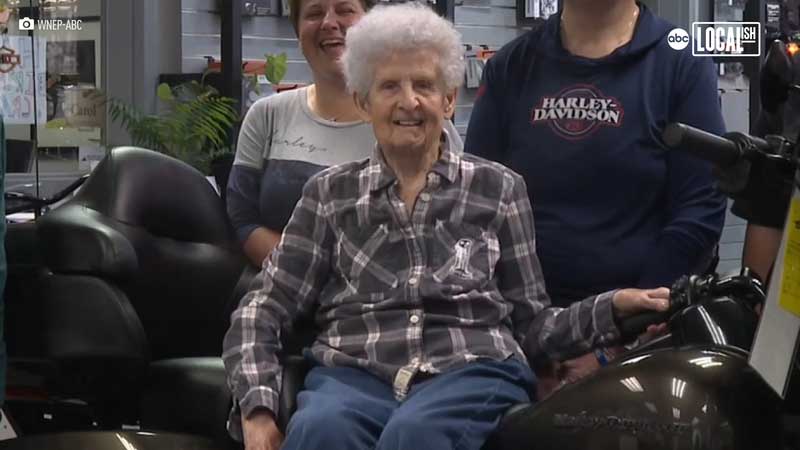
by Amanda Eustice from https://abc7.com
Ever since Schaeffer’s Harley-Davidson opened 54 years ago, Fern Schaeffer, also known as “Nana”, has been in the driver’s seat.
“Nana”, now 95 years old. was the first full-time employee when her husband and son opened the business.
Nana still works at the store sorting the mail, doing notary work, and as her family likes to put it – keeping everyone in line.
Nana loved riding motorcycles growing up and occasionally will go for a ride in the sidecar.
“She always made it that it was a woman-run business because she did the parts ordering, the bike selling, the part selling, everything back when everything first started. My grandfather and my dad were the mechanics,” says Denise Calderone, Fern’s Granddaughter.
The Schaeffer’s hope to last at least another 54 years in business and continue the legacy of being a family-owned and operated dealership.
A Trillion Here, A Trillion There…
By Bandit |
Former Illinois Senator Evert Dirksen is long credited with this quip about spending in Washington D.C., “A billion here, a billion there, pretty soon it begins to add up to real money.” An updated 21st century version of that quote would replace billion with trillion!
In March Congress passed a $1.9 trillion Covid relief bill. With the ink barely dry on that piece of legislation, conversations began about the next major bill, this one focused on infrastructure. As all MRF members know, Congress failed to pass a Highway Reauthorization bill in 2020 and extended the deadline to September of 2021. This was the bill in 2020 that had so many victories for motorcyclists, including wins on autonomous vehicles, motorcycle only check points and safety funding. It now appears likely that the Biden Administration and Congress will use the 2021 version of the highway bill as the mechanism to pass massive infrastructure spending before the end of the year.
President Joe Biden said Wednesday at an event in Pittsburgh, PA that his plan, “Will modernize 20,000 miles of highway, roads and main streets that are in difficult, difficult shape right now.” Adding that, “I don’t think you’ll find a Republican today, in the House or Senate, who doesn’t think we don’t have to improve our infrastructure. They know China and other countries are eating our lunch. So, there’s no reason why it can’t be bipartisan again.”
Transportation Secretary Pete Buttigieg insisted that the Biden administration will move swiftly to reauthorize the highway bill, which is set to expire in a little over six months. “We’ve got a clock on everything we’re doing,” Buttigieg said. “We’re not waiting until September in order to act. Conversations are taking place right now.” Speaker of the House Nancy Pelosi has set July 4th as a goal for passage of a House version of this legislation.
As we enter spring, congressional hearings are being scheduled about the scope and breadth of what this huge new bill will entail. We at the MRF will keep you updated as this enormous piece of legislation moves forward. We will fight to ensure motorcyclists priorities included in the 2020 version of the highway bill appear again in a 2021 version.
Where’s the Money Coming From?
One thing that seems clear is that any infrastructure package is going to cost a lot of money. In 2020 the House of Representatives passed version of the highway bill topped $1.5 trillion and President Biden’s 2021 infrastructure plan is in the neighborhood of $2.25 trillion. Of that $2.25 trillion, about $621 billion would go to items like road construction and repairs, mass transit improvements, passenger and freight rail modernization, investments in electric vehicles and airport upgrades. The remaining $1.6 trillion or so would go to items including the expansion of broadband, rebuilding the electric grid, drinking water projects and a laundry list of other items.
So, while Congress and the President may have the appetite for big spending, where will those dollars actually come from?
Nearly all highway funding comes from the Highway Trust Fund (HTF). Taxes on gasoline and diesel, which are the main support of the HTF, are fixed in terms of cents per gallon (18.3 cents for gasoline and 24.3 cents for diesel), and do not adjust for inflation or change with fuel prices. The rates were last raised in 1993. These taxes no longer raise enough money to support the programs Congress has authorized. In the last highway bill, the FAST Act, $70 billion was transferred from general government funds to the HFT to make up for the deficit. With the 2021 bill topping $2 trillion, the deficit between what the HFT has and what Congress spends will almost certainly be greater than in past years.
To close this deficit, Congress could cut spending, increase revenue or borrow the money. It’s clear that the first option of cutting spending is off the table. Both Republicans and Democrats have long championed spending on infrastructure as important to economic stimulation.
To raise revenue two main options have been debated. The first option is to raise the tax collected by consumers at the pump. On this topic U.S. Transportation Secretary Pete Buttigieg recently said that President Biden opposes raising the federal gasoline tax to pay for an infrastructure bill because it would violate his pledge to not raise taxes on middle-class Americans. “The President’s made a commitment that this administration will not raise taxes on people making less than $400,000 a year. That rules out approaches like the old-fashioned gas tax.”
The second option being debated to raise revenue is creation of a Vehicle Miles Traveled (VMT) tax. In its most basic sense, a VMT is tax based on how many miles a roadway user has traveled. Rep. Sam Graves (R-MO.), ranking member on the Transportation and Infrastructure Committee, said he thinks adequate technology is available to implement a VMT tax. “We can do it at the pump if we just do a simple formula,” he said, by using a national average for miles-per-gallon. “And it goes directly to the trust fund the same way it’s being done now.” Last week the U.S. Department of Transportation released a statement to reporters saying that the White House was not considering a VMT to fund infrastructure spending.
The most likely outcome is a direct transfer of funds from the U.S. Treasury to cover this proposed spending. In other words, revenue will be raised but through different tax increases or borrowing the money. Increases in the corporate tax rate as well as an increase on income taxpayers in the highest tax bracket have been floated as potential ways to generate revenue.
This spring and summer will see two monumental battles in Congress; first, how to improve our aging infrastructure and just as importantly, how to pay for it.
About Motorcycle Riders Foundation
The Motorcycle Riders Foundation (MRF) provides leadership at the federal level for states’ motorcyclists’ rights organizations as well as motorcycle clubs and individual riders. The MRF is chiefly concerned with issues at the national and international levels that impact the freedom and safety of American street motorcyclists. The MRF is committed to being a national advocate for the advancement of motorcycling and its associated lifestyle and works in conjunction with its partners to help educate elected officials and policymakers in Washington and beyond.
City of Sturgis to introduce the town’s first ever Running of the Buffalo
By Bandit |
from https://sturgismotorcyclerally.com
(Sturgis, SD) – City of Sturgis to introduce the town’s first ever Running of the Buffalo down Legendary Main Street during the 81st Annual Motorcycle Rally. The inaugural “Buffalo-Run” will feature 2,000 Bison provided by Slim Buttes and Jumpoff Buffalo Ranches and will take place Monday, August 9th at 3:00 PM.
The inaugural “Running of the Buffalo” is inspired by the traditional Spanish event, “Running of the Bulls,” and will take place on the first Monday of the 81st Sturgis Motorcycle Rally at 3:00pm. The city of Sturgis will be working through the night on Sunday, August 8th, to install protective fencing along Legendary Main Street for the safety of spectators.
According to Sturgis Mayor Mark Carstensen, “The indigenous Bison in our area are one of the many things that makes our Rally so unique. We thought adding the Sturgis Buffalo Run to our list of official events would be a great way to put a unique Black Hills spin on such an iconic tradition known around the world.”
Scott Peterson, a long-time member of the Hamster’s Motorcycle Club and owner of the Jumpoff Buffalo Ranch, is excited to add a new layer of Americana and history to the Sturgis Rally. “Being a lifelong supporter of the Sturgis Motorcycle Rally, we’re thrilled to be able to be able to provide this exciting new event. Our herd has already started training by running up and down Highway 85.”
The run will take place on Main Street in legendary downtown Sturgis among the thousands of motorcycles and riders. The herd will be released at the corner of Harley-Davidson Way and Main Street and conclude at the corner of Main and Junction. Sturgis Rally attendees will also be able to take home a commemorative “Buffalo Run T-Shirt.”
Press inquiries contact:
april.first@sturgismotorcyclerally.com
The Fools Bikernet News for April 1st, 2021
By Wayfarer |
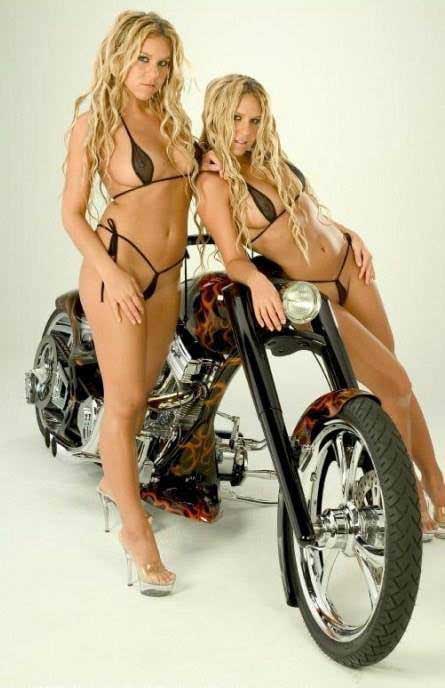
This news is completely whacked, so hang on.
The Bikernet Weekly News is sponsored in part by companies who also dig Freedom including: Cycle Source Magazine, the MRF, Las Vegas Bikefest, Iron Trader News, ChopperTown, BorntoRide.com and the Sturgis Motorcycle Museum.
Ride fast and free forever,
–Bandit



